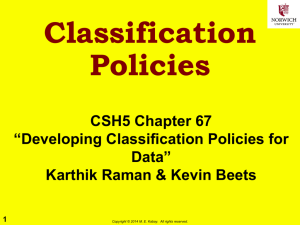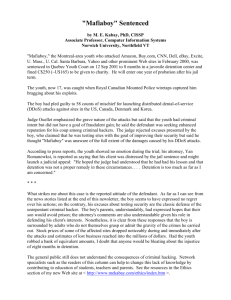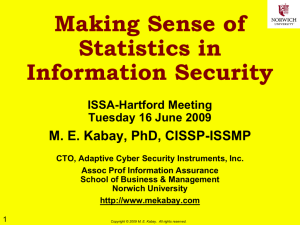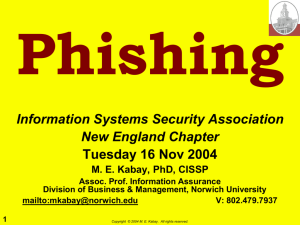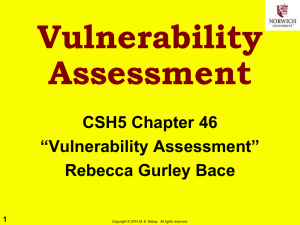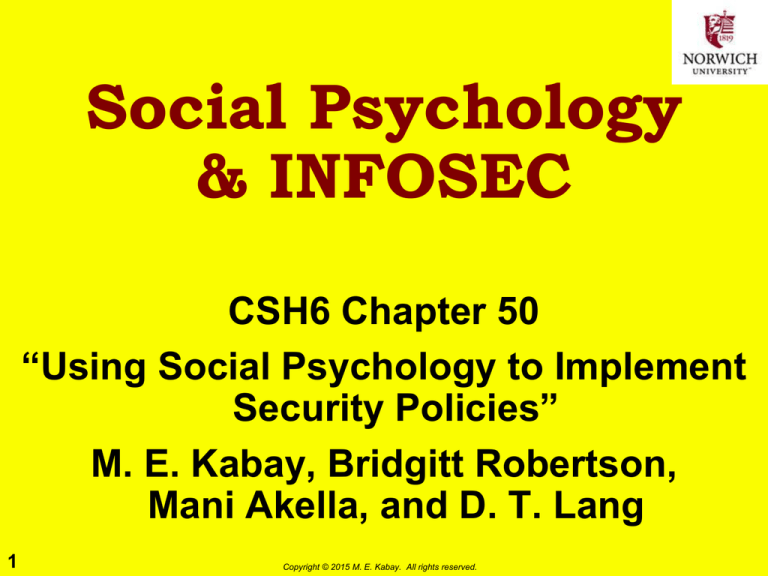
Social Psychology
& INFOSEC
CSH6 Chapter 50
“Using Social Psychology to Implement
Security Policies”
M. E. Kabay, Bridgitt Robertson,
Mani Akella, and D. T. Lang
1
Copyright © 2015 M. E. Kabay. All rights reserved.
Topics in CSH6 Ch 50*
Rationality is Not Enough
Getting Your Security Policies
Across
Encouraging Initiative
Group Behavior
_________
* NOTES:
1) Detailed, narrated lectures on organizational psychology are
available at
http://www.mekabay.com/courses/academic/norwich/msia/index.htm
as a complete lecture (15.7MB Zipped) or in parts.
2) This presentation goes beyond Ch 50 in some respects.
2
Copyright © 2015 M. E. Kabay. All rights reserved.
Rationality is Not Enough
The Schema
Theories of Personality
Attribution Theory
Social Cognition:
Forming Judgments
Intercultural Differences
Framing Reality
3
Copyright © 2015 M. E. Kabay. All rights reserved.
The Schema
Cognitive framework
What allows observations to make
sense
We interpret observations
in context
Imagine that your colleague
appears at work dressed like this:
But what if your colleagues is at
the company swimming pool?
Results in radically different
interpretation from schema for the
business meeting. . . .
In security, schema for normal
politeness conflicts with schema for
secure behavior
4
Copyright © 2015 M. E. Kabay. All rights reserved.
Theories of Personality
5
Interpersonal conflicts can
interfere with security policy
Beware rigid categories for
framing behavior in terms of
fixed personality patterns
Extroversion /
agreeableness etc.
Especially important not to
value one personality style
above another
People of all styles can
contribute constructively to
organization
Perceptions and
expectations account for
many conflicts
Role-playing exercises very
helpful
Listen carefully to people’s
expressions of feelings as well
as of opinions
Copyright © 2015 M. E. Kabay. All rights reserved.
Attribution Theory (1)
How people explain their own and others'
behavior
Weiner's classification:
Stable
Dispositions;
traits; level of
ability or
intelligence
Internal
External
6
Degree of task
difficulty; env
helps/hindrance
Copyright © 2015 M. E. Kabay. All rights reserved.
Unstable
Effort;
mood;
physical state
Good/bad luck;
opportunity;
transient
situations
Attribution Theory (2)
How we explain behavior
Fundamental Attribution
Error
Star Trek's Leonard
Nimoy is really like the
character he portrays (Mr
Spock)
Actor-Observer Effect
What I do is a reasonable
response to the situation
but what you do is in
your nature
Salience
What stands out is
perceived as most
important even if it isn't
7
Copyright © 2015 M. E. Kabay. All rights reserved.
Attribution Theory (3)
Self-Serving Bias
If I succeed it's because of how good I
am, but if I lose it's not my fault
Self-Handicapping
If I expect to fail I'll make sure there's a
good excuse
Depressed People
If I lose it's because of how bad I am,
but if I succeed it's not to my credit
8
Copyright © 2015 M. E. Kabay. All rights reserved.
Attribution Theory:
Implications
Leader and others: remember not
to pigeon-hole someone
E.g., “He’s always _______”
Reverse situation – think about explanations
for perplexing or objectionable behavior
“If I were behaving that way, it would be
because __________”
Challenge unthinking reliance on salience –
question assumptions about causality
“Why should the fact that he limps make a
difference to _________?”
9
Copyright © 2015 M. E. Kabay. All rights reserved.
Social Cognition: Forming
Judgements
1. Schemas influence perception
2. Decision-making usually includes
only a small subset of available
information
3. Language influences
perception
4. Reasoning is only a small
part of forming judgments
or opinions
10
Copyright © 2015 M. E. Kabay. All rights reserved.
Inadequate Sampling
Judgments are often based on
inadequate samples
Early, negative, information
weighted heavily
The availability heuristic can
lead to errors in judgment
What’s easy to remember
weighs too heavily in decision
Anecdotal evidence
inappropriately strong
11
Copyright © 2015 M. E. Kabay. All rights reserved.
Inadequate Sampling (cont’d)
THEREFORE
1. Provide decision makers
with powerful arguments
first
2. Ensure there’s lots of
striking, memorable
evidence in presentation
3. Explicitly challenge
incorrect intuition,
preconceptions,
conclusions
12
Copyright © 2015 M. E. Kabay. All rights reserved.
Intercultural Differences
International differences can lead to
Misunderstandings
Conflicts
History, interpretation can be
different; e.g.,
Afghani Taliban forced
non-Muslims to wear badges
in public
So how might a particular
Hindu refugee from
Afghanistan feel in the USA
being forced to wear a badge
to work?
DISCUSS such problems rather than dismissing
them
13
Copyright © 2015 M. E. Kabay. All rights reserved.
Framing Reality
Shift perception of reality
Expand range of experience
Give real-world examples
Provide opportunities for role-playing
Take time necessary to shift corporate
culture
Keep security at forefront of awareness
Address feelings of participants
14
Copyright © 2015 M. E. Kabay. All rights reserved.
Getting Your Policies Across:
Effective Communication
What influences pace of change:
Audience/Listener variables
Channel variables
Communicator/Presenter variables
Message variables
For narrated lectures on effective
communications, see
LEADERSHIP parts 3 and 4 on
http://www.mekabay.com/msia/public/index.htm
15
Copyright © 2015 M. E. Kabay. All rights reserved.
Beliefs and Attitudes
Belief: cognitive information without
affect (feelings)
“The operators are responsible for
tape mounts.”
Attitude: evaluation or emotional
response
“The */$&/! operators are supposed
to be responsible for tape mounts!”
Cognitive dissonance: incompatible
beliefs, attitudes or behavior
“I am an honest person – but I have
taken home three dozen blank CDRW disks this month from the
company stockroom.”
16
Copyright © 2015 M. E. Kabay. All rights reserved.
Beliefs and Attitudes
Before attempting to change beliefs and attitudes,
study what they are
Interviews
Focus groups
Surveys
Use language carefully
Positive terms for
desired end-point
Encouragement is
effective
Even minor praise, smile can shape beliefs and
attitudes
Allow time for change – weeks at least
17
Copyright © 2015 M. E. Kabay. All rights reserved.
Beliefs and Attitudes (cont’d)
Suggestions for security group:
Explore current beliefs and attitudes
towards security
Identify areas of conflict,
negative affect
Correct erroneous beliefs fast
Explore why some policies are
successful
Provide consistent pro-security
messages to avoid dissonance
E.g., managers should not ignore
polices
Rewards more effective than
punishment
Encouraging positive attitudes &
behavior
18
Copyright © 2015 M. E. Kabay. All rights reserved.
Prejudice
Stereotypes – simple models of others;
e.g., racial profiling, assumptions about
security officers
Roots of prejudice are many – historical, social,
familial, psychological, personal
Authoritarian personality includes prejudice
Minimal-group research – easy to generate intergroup hostility and prejudice simply by grouping
Group competition exacerbates prejudice
Creating common goals and projects for
hostile groups mitigates prejudice
Favorable depictions improve inter-group
relations
19
Copyright © 2015 M. E. Kabay. All rights reserved.
Encouraging Initiative
Prosocial Behavior
Conformity,
Compliance and
Obedience
20
Copyright © 2015 M. E. Kabay. All rights reserved.
Pro-Social (Helpful) Behavior
Acting helpfully requires 4 steps:
Notice problem
Need awareness
Recognize as emergency
Need training
Take responsibility for action
Need climate for responsible action
No worry about looking foolish
Decide on action
Sound training, good policies
21
Copyright © 2015 M. E. Kabay. All rights reserved.
Pro-Sociality (cont’d)
Bystander Effect
Larger groups have slower reaction time
Diffusion of responsibility
Uncertainty about social climate
Counter bystander
effect using rewards
for responsible
behavior
E.g., reporting
security violations
Challenging
unbadged
strangers
22
Copyright © 2015 M. E. Kabay. All rights reserved.
Pro-Sociality (cont’d)
Cost-benefit analysis
Make prosociality low cost / high gain
Provide hotline for security violations
Allow anonymity in reports
Make failing to support policy expensive
Personnel policies: clear sanctions
Performance review
Possible dismissal
23
Copyright © 2015 M. E. Kabay. All rights reserved.
Conformity, Compliance and
Obedience
Shift normative values towards goal
Express expectation of cooperation – “We”
Group solidarity increases conformity
Group exercises, games, teamwork
If using contests, mix up the teams
Outliers are especially important
Both enthusiasts and resisters
Norm of reciprocity
Give a little, get a little
Foot in the door
Get a little, get more
24
Copyright © 2015 M. E. Kabay. All rights reserved.
Group Behavior
Social Arousal
Locus of
Control
Group
Polarization
Groupthink
25
Copyright © 2015 M. E. Kabay. All rights reserved.
Social Arousal
Large groups cause “social arousal”
Increased awareness of self and others
Facilitates well-learned habits
Interferes with poorly-learned habits
Therefore avoid large groups for early security training
Provide individualized learning as major tool
26
Copyright © 2015 M. E. Kabay. All rights reserved.
Locus of Control
People work better
when they feel in
control
Able to affect
outcomes
Considered by
decision-makers
Listened-to
Experimental
evidence
Teams working in
noisy environment
Patients in
convalescence
homes
27
Copyright © 2015 M. E. Kabay. All rights reserved.
Locus of Control (1)
Locus of Control Group 1
28
Copyright © 2015 M. E. Kabay. All rights reserved.
Locus of Control (2)
Locus of Control Group 2
STOP
29
Copyright © 2015 M. E. Kabay. All rights reserved.
Locus of Control (3)
30
Copyright © 2015 M. E. Kabay. All rights reserved.
Group Polarization
Groups take on more extreme positions than any
one member would
E.g., can decide to take more risks (or fewer)
than reasonable
Emphasize one-on-one discussions to counter
polarization
Group Polarization in the Blogosphere
Re-evaluate group
decisions after
enthusiasm has
cooled
31
From http://www.zonaeuropa.com/ 20050312_1.htm
Copyright © 2015 M. E. Kabay. All rights reserved.
Groupthink
Desire for social
Challenger:
cohesion can lead to
January 28, 1986
flawed thinking
Reject contrary
evidence
Condemn anyone
questioning
consensus
Protect leader
against
“disturbing” views
Factors increasing
likelihood of
groupthink
Authoritarian
leader
Pre-existing
agenda
Rejection of debate
Should fight
groupthink at all levels
32
Copyright © 2015 M. E. Kabay. All rights reserved.
Review Questions (1)
1. How does the schema affect information assurance?
2. How can faulty interpretations of personality interfere
with IA practitioners’ ability to work effectively in an
organization?
3. How do unsophisticated explanations of behavior
interfere with effective security administration?
4. What is meant by “making security part of the corporate
culture”?
5. Discuss three key elements for changing employees’
schemas to improve receptivity to security policies.
6. Why is it valuable to evaluate current beliefs about
security issues (explain with respect to cognitive
theory).
33
Copyright © 2015 M. E. Kabay. All rights reserved.
Review Questions (2)
7. What are the most effective mechanisms for motivating
better attitudes toward security and greater compliance
with security policies?
8. Analyze the case of the Hershey’s Kisses on the
keyboard.
9. Name and define the four types of variables affecting
the effectiveness of communications designed to
change attitudes.
10. Explain how each of the four communications variables
can be optimized for effective attitude change in
security training.
11. How can one encourage employees to take the initiative
in responding to security breaches and reporting
questionable behavior?
34
Copyright © 2015 M. E. Kabay. All rights reserved.
Review Questions (3)
12. How does team spirit influence the work of IA trainers?
13. Why should IA trainers and security personnel pay
attention to outliers?
14. How does the norm of reciprocity play a role in security
policy efforts?
15. What is the significance of the “foot-in-the-door”
technique for security training and awareness efforts?
16. When should security training be offered to large
groups and when to small groups? Why?
17. What is the meaning of “locus of control” for security
efforts?
18. How can one avoid the dangers of group polarization
and groupthink in security training and awareness
efforts?
35
Copyright © 2015 M. E. Kabay. All rights reserved.
Optional Homework
For 5 points, submit an essay of 100-200 words
Bring to light an article illustrating any principle in the
chapter on Social Psychology and INFOSEC
Do some research in the Kreitzberg Library databases,
Google Scholar, and the WWW
Put your summary in NUoodle Class Discussion forum
You may refer to a page number in the chapter or to a
slide number in the PPT file to point out where the
topic is mentioned.
Be sure to provide a complete reference to your
source so others can find and read it.
For up to 5 points per response, comment constructively
on other students’ postings on these social-psychology
illustrations.
36
Copyright © 2015 M. E. Kabay. All rights reserved.
Now go and
study
37
Copyright © 2015 M. E. Kabay. All rights reserved.


